Minimalisms Now: Race, Affect, Aesthetics
The offices of biotech company Lumon are empty. Hallways and rooms are bare, though not totally insipid. Once exiting the corridors, workers' units bear a splash of colour — green or blue — and small personal details (a picture on a desk, a box of tissues, a clock) that offset the sterile atmosphere. In the foyer, a picture in the classical style holds focus. In the CEO's office, a painting of turbulent weather occupies three panels; a plant breathes life into the antiseptic room. Indeed, it is a company where small details are highly productive. Despite the show's futuristic premise, Lumon's computer, switchboard, and camera models all harken to the past. This is an aesthetic maneuver, invoking, perhaps, the digital era's affinities for quaint technology — the return of record players and polaroid cameras — but it is also, arguably, functional: the appearance of analog technology likely placates workers' due anxieties of Lumon's advanced, surveillant mechanisms of control. Minimalism at Lumon, whether in décor or old-school technology, extends to the ethos itself: conversations seldom deviate from work; they are focused and stripped of excess. Nonetheless, small details stave off suspicion. Morning greetings, such as the idiosyncratic "Hi kids, what's for dinner?" offered by one employee, Irving, offer reassurance: everyone here is human.

Released February 2022, Apple TV's Severance thrusts the viewer into an uncanny situation: a sci-fi world of quantum physical distortion and relatively ordinary corporate architectures. It is a futuristic show about the tech industry, whose central quarters epitomize today's general spirit of digital minimalism:1 Silicon Valley's general aptitude for glass and modernism takes a specific shape in the sleek sterility of an iPhone. Moreover, the vacant encounters at Lumon, often deprived of social texture and depth, if satirized, are so only slightly. CEO Colby, informing protagonist Mark, following his promotion, that "a handshake is available upon request," affirms what Sianne Ngai describes as "capitalism's classic affects of disaffection." The effect is to illustrate Ngai's point that, in the twenty-first century, such affects "are neatly reabsorbed by the wage system and reconfigured into professional ideals."2
Severance's minimalist ethos functions as a somewhat intuitive background to its corporate satire, which conveniently makes room for its mind-bending premise. In a world not far from our own, Lumon has introduced "severance," a procedure severing employees' work and leisure consciousnesses and thus, inferably, improving workers' productivity (and career prospects) as a decluttering of the mind and purging of personal distraction. Those who undergo severance will possess two separate consciousnesses: their "innie" selves, whose only sentient experiences subsist of work, and their "outie" selves, who only know their life outside Lumon. As a plot device, therefore, severance utilizes a far-fetched concept to meditate on ordinary states of capitalist crisis, invoking how directional affects (such as ambition) remit, to use Lauren Berlant's phrase, forms of "cruel optimism," or desires at odds with one's own flourishing.3 Severed workers are reminded during orientation that they underwent the procedure of their own free will. Yet, it is abundantly clear that innies get the short end of the stick. Moreover, it is only upon being relegated to an innie that the limits "free will" and the cruelness of the procedure begins to crystallize. As one innie notes, it takes "a monster to put someone in a place like [this] office, especially if the person [is] himself."
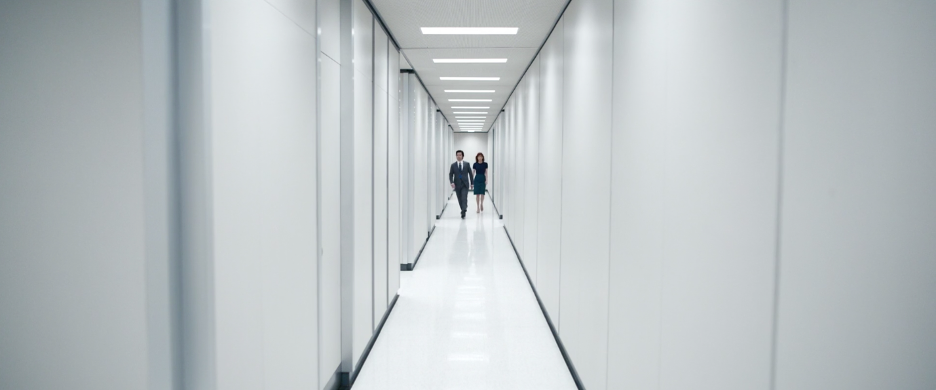
Severance is thus otherworldly and timely. Its release coincided with shows like Squid Game that thematize choice amidst monetized distress, and also with The Dropout and Succession, which mediate on corporate unaccountability. In short, it participated in a broader query into capitalism's rendering lives and bodies disposable. The question posed to outie Mark by a friend — "do you even know what you do in there?" — rhetorically invokes the show's literal premise of cognitive disconnect. Yet it also invokes an ethos of western corporate capital wherein "violence [is kept] firmly out of view," wherein the "modern technocrats of empire [ . . . ] likely spend their lunch breaks stalking their ex-girlfriends Instagram accounts, posting on 4chan" and "little evidence links the decisions made in [the] metropolitan office to the crimes enacted 'over there.'"4 While Severance may be science fiction, the drive it postulates — toward the sequestration of work and personal matters as means of reducing accountability — is not.
The urgency of these political provocations threatens to obscure the minimalist aesthetics that underwrite them. As Alexis Nedd suggests, in relation to the show's "anticapitalist takedown of toxic labor practices," Severance's "sterile, unsettling Lumon offices [are] a wonder of set and production design [but] wouldn't invoke much without cinematography."5 In the show's metaphysically distorted world, Lumon's sparse office is, seemingly, the only aspect of the show dissuading deep analysis. And yet, it is perhaps because Severance's minimalist set registers as somewhat ordinary that it warrants scrutiny. As a recognizable aesthetic, Lumon's minimalism tethers the corporate logics of Severance's world to our own; in a show about excessive labor exploitation, hyper-productivity, and overload, these aesthetics function both intuitively and paradoxically. Minimalism, in Severance, thus might reveal something less explicit within the show's refraction of the present and its louder enactment of toxic labor practices. It might reveal the ordinary, contradictory, affective-aesthetic ways such practices are sustained.
Indeed, while minimalism has (especially in recent years) been vested with the innate promise of anti-consumerist "improved living," 6 (and thus, a kind of inherent moral significance) its relativity is also maintained. Warren Motte asserts that if minimalism is inherently anything, as the notion that "small things can signify abundantly" it is paradoxical. It is ironically "through a reduction of means [that] minimalists hope to achieve an amplification of effect." At political stake in matters of minimalism is what minimalism itself comes to occupy, or effect — its ample space. These dynamics are evident in Severance's very premise. As a procedure seeking to mentally "declutter" worker consciousness, theseverance procedure invariably amplifies Lumon's worker productivity. In other words, the procedure's purging of workers' outside world investments is an amplification of Lumon's investments in optimized labor. While the procedure thus might be a sci-fi invention, it also bespeaks Lumon's very ordinary desire to manage the threat of disorder when work and personal coincide, or, when the amount of "stuff" overwhelms the set task at hand.
Severance, while satirizing toxic labor practices, thus posits minimalism as an intimate accompaniment to such labor practices. In that, the show provokes the counterintuitive ways minimalism lurks in discourses of labor and leisure, today. Maha Abdelrahman's discussion of online avatars with the advent of remote work — an affordance that reduces worker exhaustion by minimizing online presence — asserts contingency between worker accommodation and labor optimization. In inviting workers to utilize an avatar, corporations nurture capitalism's "indefatigable worker" who, thanks to technological innovation, can extend working hours through a veneer of corporate benevolence. In the invitation to reduce, and yet ultimately sustain, one's labor output, Abdelrahman asserts, lies a resounding reminder that "capitalism does not let a good crisis go to waste."7
Lumon's labor economy, as premised on the rearranging of workers' natural capacity for mental space, also captures minimalism's direct relation to maximization. Whereas Abdelrahmen's work reveals the ways in which "worker accommodation" belies worker optimization, Jennifer Sandlin and Jason Wallin emphasize minimalism's directly consumerist drive. Observing the rise of popular lifestyle guru Marie Kondo, minimalism's current "cultural moment," they assert, enacts an economy wherein "things that fail to 'spark joy' become consigned to garbage dumps and landfills that today swell with the abject accumulation of consumer society." Minimalism, in such contexts, "remits the world of objects to 'popular taste' and intensifies the consumption of [ . . . ] products of the minimalist lifestyle." If the kind of minimalism that finds expression in the form of an avatar substitute belies corporate investment in the "indefatigable worker," then minimalism's cultural moment belies its "ripe[ness] for commodification."8
Reading minimalism as an amplification of labor optimisation and consumerism exposes the political valence of Severance's "sterile, unsettling Lumon offices."9 The sole task of Mark's Macrodata Refinement Unit is to sort numbers based on the feeling they emit through the computer screen. The task is monotonous and devoid of purpose — the reward of reaching the "next level" seemingly provides the only incentive. The work, bent on concentrated transductions from feeling into data, is thus both wholly consuming and pointless. In that, it acutely recalls its space. If affects "always travel through an 'associated milieu' composed of some form of matter or another," the Macrodata Refinement Office's minimalist milieu proves essential to work that is at once highly concentrated and without meaning.10 The Unit is circular and hermetic — its sparsity strategically mobilizing, and importantly justifying, its ethos of concentration for the sake of concentration, productivity for the sake of productivity, and work for the sake of work. As the show's primary space, the office of the Macrodata Refinement Office — as sterile as a laboratory and as cavernous as a football field — gives one early indication that Severance's minimalism is not "an afterthought to [its] political and epistemological enquiry but a crucial entry point to it."11 Minimalism, Severance suggests, is intimately entangled with the capitalist clutter and psychology it ostensibly counteracts — not so much an antidote to overload, but a "landfill for [its] overwhelming and impending crisis."12
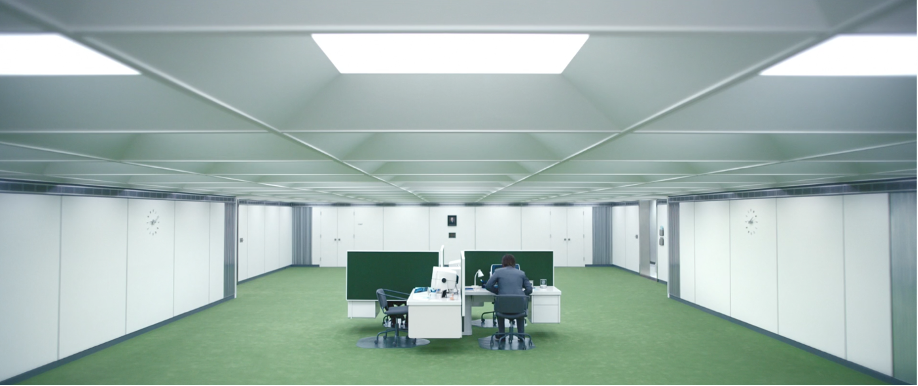
To read Severance by way of minimalism thus illuminates Lumon's day-to-day. Notably, it provokes the ordinary manifestations of the procedure itself. These first signs of these severed (or, decluttered) outie and innie states become visible in the protagonist, Mark. Parked outside the Lumon offices, outie Mark sits in his car crying, clutching a Kleenex. Mark, we learn early on, is grieving his recently deceased wife (the reason, inferably, underlying his choice to undergo severance). Mark then exits his car, walks into the Lumon offices, and enters an elevator. Halfway through the ride, his eyes close and then reopen, as if entering a brief sleep. The elevator lands, the door opens, and innie Mark — a new jaunt in his step — enters the hallway. Enroute to his office he discards his used tissue in a garbage — the only decor in the otherwise long, empty tunnel.
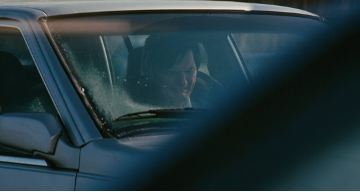
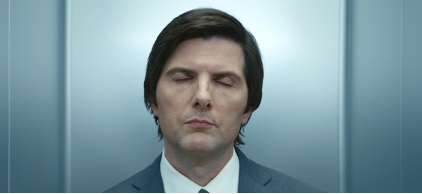
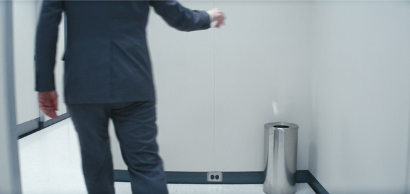
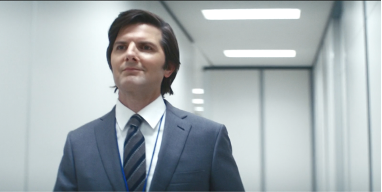
The tissue animates minimalism's capacity to signify abundantly. As it is balled up and discarded in a convenient wastebasket, it affirms Lumon's affinity for functional decor and usefully cues Mark's outie to innie transition. Importantly, it reveals something about Lumon, namely, its subsistence through economies of emotional use-value. Non-productive affects such as grief appear discardable, along with old coffee cups and stir sticks. This severed ability to shed non-productive feelings enables Mark to climb the corporate ladder. Mark, we soon learn, gets promoted, as his ease and lack of distraction make him an intuitive leader. From this position, Mark comes to supervise newly severed newcomer, Helly. Yet unlike Mark, Helly is not amenable to the procedure nor convinced by its language of "choice." Whereas Mark understands his innie life as the product of his own choices, Helly sees her indentured circumstances as her outie's decision, solely. This self-reflexive understanding of disjointed power relations drives Helly's persistent unrest: More than the task of microdata refinement, Helly's output is defined by escape endeavours, efforts to contact her outie by leaving the severed floor with notes, the issuing of formal complaint, and demanding of the procedure's repeal.
Helly, as an encumbrance to Lumon's standardized operations, thus becomes a figure of excess. Here the show's portrayal of waste proves significant. If Mark's discarding of the tissue symbolized adherence to Lumon's ethos, Helly's attempts to smuggle notes of discontent out of Lumon — a repurposing of scrap paper and legitimizing "non-productive" affects — diametrically opposes Lumon's minimalist economies. Importantly, Helly's excess renders visible Lumon's managerial maintenance of such economies. As Mark reminds Helly: "Every time you come back here, it's because you chose to." It's an assertion revealing how "choice" is differently contended with, but importantly, how its complexity is strategically belittled at Lumon: What is distressing to Helly is, to Mark, mere fact. It's a bizarre, otherworldly situation invoking ordinary institutional life. Complaint appears here as it does to Sara Ahmed: as the labor of noticing and investing in conditions contrary to institutional goals. "To be heard as complaining is not to be heard," Ahmed suggests, and to be heard as complaining creates grounds for easy dismissal. Complaint works against the desire to simply proceed, and it is hence a "killjoy genre" — a form of negative surplus hindering a system's smooth, streamlined efficiency.13
Yet, if Helly's complaints oppose and reveal Lumon's regulation of excess, her very disposition exceeds Lumon's emotional repertoire. Moving from frantic enactments that range from throwing herself out the door and hurling office equipment at Mark to quieter bouts of paranoia, Helly expresses her sense of exploitation with a broad range of emotions. Her decision to repeatedly throw herself out of the exit appears as an irrational performance, given that she is immediately teleported back, and it stands in stark contrast to Mark's calm adherence. Indeed, rather than getting frantic himself, Mark simply watches her with the understanding that her actions are futile. Mark, in the world of Lumon, is hence, reasonable — so much so that the terms of Helly's "unreasonableness" seem nearly a matter of personal disposition: in relation to Mark, Helly, it seems, isparticularly difficult. And yet, Helly's frantic, apparent lack of reason is a crucial index to the structural conditions of Severance's world — conditions Mark's calm disposition would have you forget. "Things get zany," as Ngai suggests in her theory of late capitalist aesthetics, "when [ . . . ] occupational performances excel far beyond [ . . . ] expectations."14 If the zany "has a stressed-out, even desperate quality" it is because it "is an aesthetic of action pushed to strenuous and even precarious extremes."15 The "zany," Ngai asserts, is a crucial aesthetic of late capitalist life precisely due to the standardization of occupational excess. Helly has, after all, learned that she will work (and only work) for the rest of her life.
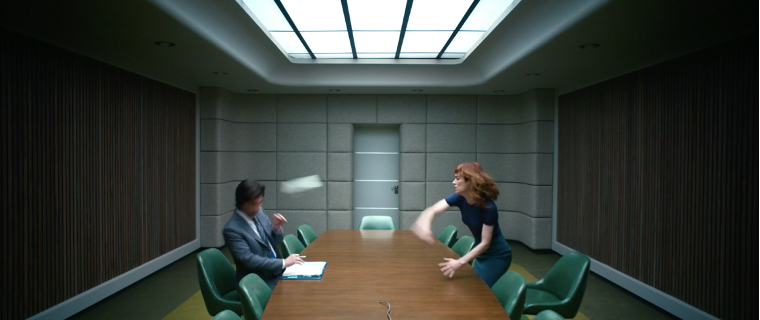
Helly's expressiveness thus enacts visceral refusal to simply proceed and reveals the ordinary ways such refusal is managed at Lumon, as a corporation bent on doing just that. Yet Helly is not the only figure of excess at Lumon. When Irving hallucinates that black sludge is coming through the office walls — conjuring a burst pipe, or a landslide — Lumon's minimalist atmosphere gives way to the maximalism of a "landfill for overwhelming and impending crisis."16 Irving's hallucinations likewise provoke (and hence reveal) Lumon's range of placatory, minimizing techniques. Yet, whereas Helly's behavior was punished with a trip to the break room, Irving's hallucinations render him not a threat to Lumon's operations so much as concern. Irving, rather than being punished, is thus granted a visit to Lumon's basement Wellness Center.
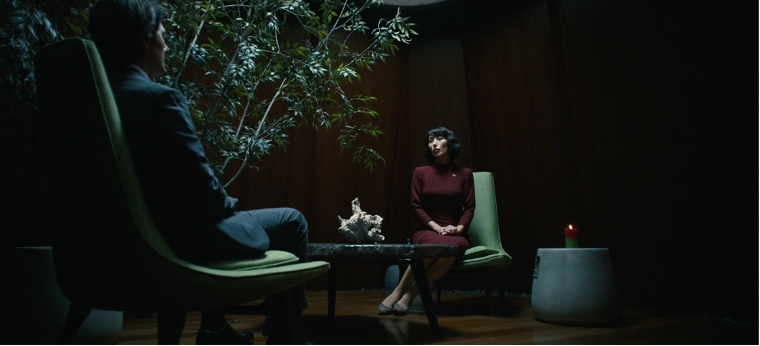
But where Helly's punishment was designed by Lumon to dispirit her, Irving's wellness check strives outwardly to comfort. The Wellness Center adheres to the decorum of well-being: The room is dim and ascribes to feng shui. It is pleasantly simple, and reminiscent of a hotel spa or float tank. Ms. Casey herself is recognizable — her calm, feminine tone invoking the intonations of today's many guided meditations podcasts. And yet, despite its veneer, Irving's "wellness check" nests Lumon's investments in an optimizable, disaffected workforce. As Ms. Casey instructs, she will read Irving facts about his outie and he will respond with as little emotion as possible. In its conflation of worker "wellness" and corporate objectives, the scene elaborates minimalism's duplicity. In Lumon's architectures of accommodation — the convenient location of the basement wellness center, and the recognizably minimalist aesthetics of the center itself — the "increasing colonization of worker subjectivity and affect,"17 the imploding distinctions between work and leisure, and the "indefatigable worker," who will eat, sleep, and, indeed, recover at the office, emerge. Minimalism's cultural lexicon of self-care and retreat, the scene suggests, is inseparable from a capitalist lexicon of overwork; mindfulness has indeed "become individualized and psychologized as a technique for improving individual's functioning within a capitalist society."18 The Wellness Center functions less as a retreat from Lumon's corporate mission than as a landfill for and engine of it.
***
This critique of toxic labor practices depends on Severance's commitment to minimalism, which lends itself readily to the top-down logics of corporate capitalism and the practices of space-making, decluttering, and indeed mindfulness that have accompanied it. The thesis of the show sounds cynical yet is anything but. It appeals to the very quotidian possibilities of refusal — to performative, creative, and visceral methods of occupying space and holding space that resist and reimagine present organizations of labor. As it refracts the realities of the "death-drive-disguised-as-worldview — the murderous episteme that is being imposed on us by the master/settler/CEO,"19Severance joins anticapitalist thinkers in asking: "What does it mean to try to build worlds that affirm, rather than destroy, life, and to do so from outside the barricade?"20 What does it mean to clutter, disorder, distract, overwhelm, and populate the "accommodations" capitalist worlds provide, the "gifts" they bestow, and the logics of efficiency and organization they enable? Severance endows minimalism with the ability to provide a "landfill for overwhelming and impending crisis." In doing so, it advocates a rethinking of purging as ordering, reminding, through the distractions of zaniness, the imagery of waste, and the generative excess of complaint, that "disorder is not the same as chaos," and indeed, that it is vital.21
Sadie Barker (@blaise_barker) is a PhD candidate in the Department of English at Concordia University and the co-founder/co-editor of Refractions: A Journal of Postcolonial Cultural Criticism. Her research explores the relations between aesthetic and postcolonial theory by way of visual art, television, and literature. Her writing can be found in Canadian Literature, Women & Performance, English Studies in Canada, Refractions, and elsewhere.
References:
- See Hartmut Obendorf, Minimalism: Designing Simplicity, Human-Computer Interaction Series (Dordrecht: Springer, 2009).[⤒]
- Sianne Ngai, Ugly Feelings (Cambridge: Harvard University Press, 2005), 4.[⤒]
- Lauren Berlant, Cruel Optimism (Durham: Duke University Press, 2011).[⤒]
- Robyn Maynard and Leanne Betasamosake Simpson, Rehearsals for Living, The Abolitionist Papers Series (Chicago: Haymarket Books, 2022), 12.[⤒]
- Alexis Nedd, "'Severance' review: An anti-capitalist fable with a 'Black Mirror' twist," Mashable, February 18, 2022.[⤒]
- Thomas Phillips, The Subject of Minimalism: On Aesthetics, Agency, and Becoming (New York: Palgrave Macmillan, 2013). [⤒]
- Maha Abdelrahman, "The Indefatigable Worker: From Factory Floor to Zoom Avatar," Critical Sociology 48, no. 1 (2022): 84.[⤒]
- Jennifer A. Sandlin and Jason James Wallin, "Decluttering the Pandemic: Marie Kondo, Minimalism, and the 'Joy' of Waste," Cultural Studies ↔ Critical Methodologies 22, no. 1 (2022): 96. [⤒]
- Nedd, "'Severance.'"[⤒]
- James Ash, "Technology and Affect: Towards a Theory of Inorganically Organised Objects." Emotion, Space and Society 14, no. 1 (2015): 84-90, p. 85. [⤒]
- Matthew Fuller and Eyal Weizman, Investigative Aesthetics: Conflicts and Commons in the Politics of Truth (London: Verso, 2021), 67. [⤒]
- Berlant, Cruel Optimism, 3.[⤒]
- Sarah Ahmed, Complaint! (Durham: Duke University Press, 2021), 1.[⤒]
- Sianne Ngai, Our Aesthetic Categories: Zany, Cute, Interesting (Cambridge: Harvard University Press, 2012), 175. [⤒]
- Ngai, Our Aesthetic Categories, 185.[⤒]
- Berlant, 3[⤒]
- Jason Hughes, "Bringing Emotion to Work," Work, Employment & Society 19, no. 3 (2005): 611. [⤒]
- Steven Stanley, "Mindfulness: Towards a Critical Relational Perspective," Social and Personality Psychology Compass 6, no. 9 (2012): 632.[⤒]
- Maynard and Simpson, 24.[⤒]
- Maynard and Simpson, 25.[⤒]
- Maynard and Simpson, 26.[⤒]
